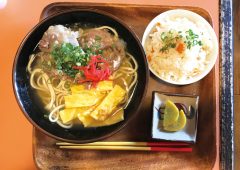2014.07.12
Ishigaki Beef possesses amazing healthy qualities
By David Higgins
When the phrase “Japanese beef” is mentioned, the first thing that comes to mind is Kobe beef. However, there is another type of beef produced in Ishigaki, Okinawa, that possesses many of the very same characteristics that make Kobe beef so prized.
Ishigaki Island is over 1900 km away from the Japanese capital of Tokyo. As it is quite a remote destination, those not familiar with Japan may not have heard of it. For those who are familiar with Ishigaki Beef, it is difficult to get it fresh as usually the beef has to be frozen to be transported to its final destination.
Only 20% of the cattle born on Ishigaki remain there to be raised locally, according to Ishigaki producers; the rest are transported to other regions within Japan.
Before discussing any specifics of beef related to a certain Japanese region, it’s important to understand the many commonalities of beef production across all regions in Japan. This is useful in understanding why all Japanese beef has such similar characteristics that make it so prized and so delicious.
The name for all Japanese beef cattle is Wagyu. As with so many Japanese words, this is a hybrid of two words; wa means Japan, and gyu means cow. Together they translate to “Japanese cow”. In order to be classified as a Wagyu cow, the cow must be born in Japan to parents who are 100% Wagyu.
All beef from Japan, including Ishigaki beef, is characterized by the amount of marbling it has due to the presence of fat in between the layers of meat. The fat itself is referred to as “sashi” in Japanese. And while it is the trend of North America to avoid fat in red meat, it is this fat that gives the Ishigaki beef an amazing flavor and tenderness that is like no other form of beef.
To use a comparison to help illustrate how the marbling helps flavor, in the United States the top designation of beef is USDA Prime, which has 6-8% of marbled fat.
Ishigaki Beef (like all top-grade beef from Japan) must have at least 25% marbling to receive the highest marks for quality when graded.
Contrary to popular belief, the fat in Japanese cattle is actually monounsaturated fat, which has the effect of lowering bad cholesterol. So consuming Ishigaki beef, while delicious, is also good for health.
Not all fat within cattle is the same. The fat within Ishigaki Beef has a lower melting point. The result is that the sensation of the beef fat doesn’t linger in the mouth, creating a more appetizing result on the palate. Also, while this form of Japanese beef is tender, it still has a nice texture to it. These differences in the beef’s taste and texture are solely due to how the Wagyu (Japanese cow) are raised. The Wagyu are walked often, usually daily, to ensure they receive plenty of fresh air and sunshine. They also receive a carefully chosen diet (each farmer’s recipe is different, of course, and is a carefully guarded trade secret). Sometimes the cattle are even rubbed with sake to help deter any pests from bothering them.
All in all, Japanese beef has a different taste and texture that makes it one of the best meats in the world. This flavorful form of beef has to be tasted to be believed!



 2024.04.10
2024.04.10 2024.01.31
2024.01.31 2024.01.02
2024.01.02 2023.12.27
2023.12.27 2023.11.16
2023.11.16 2023.11.14
2023.11.14 2023.11.10
2023.11.10 2023.10.26
2023.10.26 2023.10.16
2023.10.16 2023.09.14
2023.09.14






